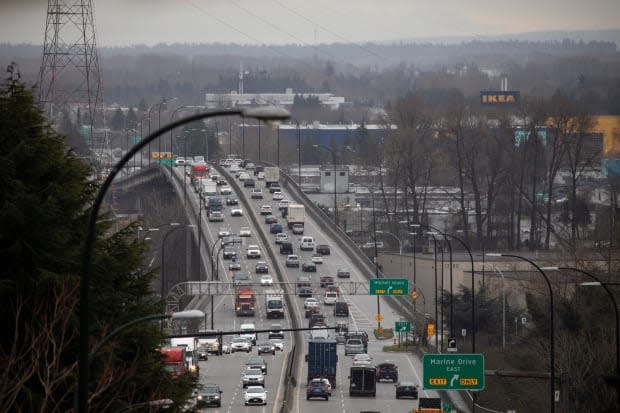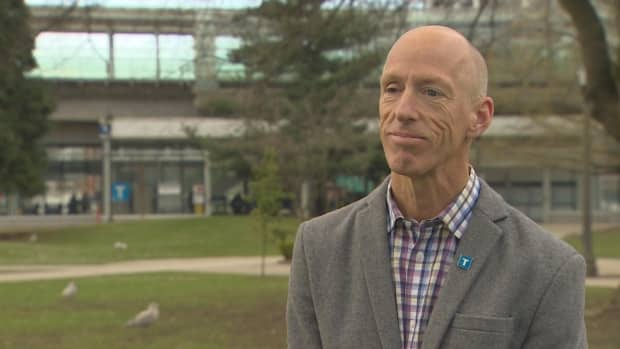Post-pandemic traffic in Metro Vancouver could be worse than ever, expert warns

Brett Langdeau used to take the bus every day to his job at Home Depot in Coquitlam, B.C. But that all changed once the pandemic hit.
"A large part of it was due to fear. I didn't want to be in an enclosed space with a bunch of other people," said Langdeau, who would take the bus from his home in the city.
He borrowed his parent's car and has been driving to work ever since.
Experts say Langdeau's story is common, and it's one of the reasons traffic levels are high in Metro Vancouver even though many people are still working from home. And traffic volume, they warn, will most likely exceed pre-pandemic levels as confidence in taking transit recovers slowly, even as more people get vaccinated and return to the workplace.
Recent data from TransLink shows that crossings on three major bridges in Metro Vancouver owned by the transit authority — Golden Ears, Pattullo and Knight Street — are within 10 per cent of pre-COVID volume.
The data from the transit authority compares the average number of weekday crossings every month from the beginning of 2019 until March 2021.
On the Pattullo Bridge between New Westminster and Surrey, there was a definitive drop in crossings in the first few months of the pandemic, but traffic volume quickly rebounded. Last month, an average of 62,078 vehicles crossed the span on weekdays — only around five per cent less than the figure for February 2020, the month before sweeping pandemic restrictions were introduced.
It's a similar story on the Knight Street Bridge between Vancouver and Richmond, where there were an average of 94,166 daily crossings on weekdays in February, a decrease of only nine per cent compared to February 2020.
Meanwhile, last month, the Golden Ears Bridge connecting Langley with Pitt Meadows and Maple Ridge saw its highest number of average weekday crossings since August 2019, at 67,174.
While traffic levels are high on the roads, there's been a huge decrease in ridership of about 60 per cent on transit, according to TransLink.
The pandemic caused a big disruption in travel behaviour, says SFU associate professor of health sciences Dr. Meghan Winters.
"A lot of people did shift their travel modes. People who had choices stopped using transit. StatsCan data says that three-quarters of those people went to drive in their private vehicles," she said.
Winters says people's travel behaviours generally only shift due to big disruptions in their lives like buying a house, finding a new romantic partner, retiring — or a global pandemic.
"The kind of interruption or disruption we saw with the COVID lockdown was completely unprecedented," she said.
Learned habits could lead to congestion
Congestion levels on major crossings are something TransLink is keeping a close eye on, especially as transit ridership numbers have plummeted.
"People are not sharing small spaces. Whether that be shared rides, carpooling, or on transit," said Geoff Cross, vice-president of planning and policy at TransLink.
It's a problem Winters doesn't see going away once we are all vaccinated.
Transit riders have developed new learned habits through the pandemic, she says — and she's not convinced vaccinations will be a big enough event to push them back to shared transit options.
"When we are all vaccinated ... it's not going to feel like that same disruption. So it's not going to have that same kind of intervention feeling. And, I would say, it's likely that people will be slow to make those behaviour changes," said Winters.

With traffic levels already close to normal, she predicts the return to in-office work and in-classroom studies will equal major congestion on the Lower Mainland's roads.
"There's not capacity on our roads. We were in a state of congestion that was having social and economic impacts pre-COVID," said Winters.
'Robust' recovery in ridership predicted
Once the government says it's safe to encourage larger numbers back to transit, Cross says TransLink expects some hesitancy over the first few months as riders test their comfort levels, but he's confident ridership will rebound.
"We do believe that there will be a very rapid and robust recovery into 2022," he said, adding that congestion on the roads over the first few months post-vaccination could actually encourage more people to return to taking the bus or SkyTrain.
He says the team is preparing a campaign to welcome riders back and convince them of the system's safety.

The Ministry of Environment and Climate Change Strategy — which is responsible for TransLink — says it's looking to the transit authority to convince the public to, once again, ditch their vehicles.
"We are confident that British Columbians will make increasing use of transit as we emerge from the pandemic," it said in a statement.
But Langdeau says his return to transit will be decided by the numbers, even if he has been vaccinated.
"If we have a transmission rate that's going up, I would be hesitant to get on the bus at all," he said.

